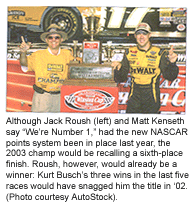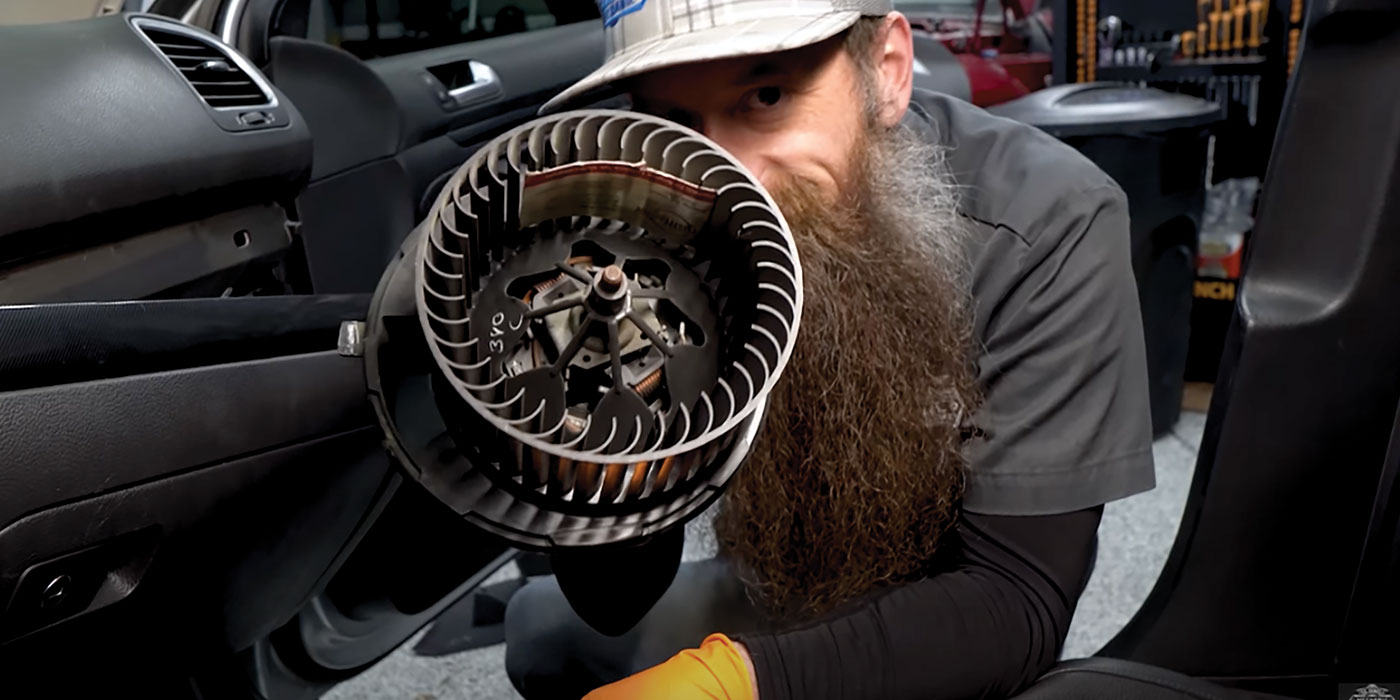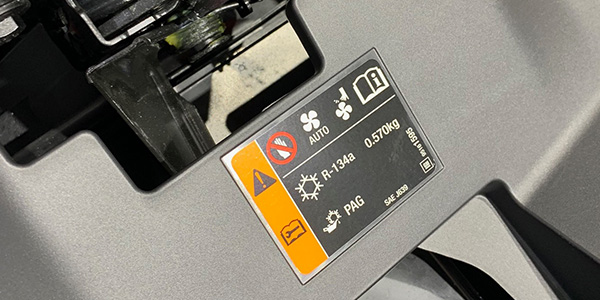With the opening of the 2004 NASCAR racing season, several key competition changes affecting the three national series have been put into place.
One of the most significant changes has been to NASCAR’s qualifying system for the NASCAR NEXTEL Cup Series and NASCAR Busch Series. In 2004, these series will raise the number of cars that make the 43-car fields via qualifying times from 36 to 38. This move reduces the amount of provisional starting positions assigned to a field from seven to five. The “champion’s” provisional remains in place for the 43rd and final starting position when applicable. Car owners in the top 45 positions of the 2003 owner championship standings will receive four provisionals at the outset of the season and will receive an additional one after attempting to qualify for six events for a season maximum of 10. The previous season maximum was eight.
Car owners not among the top 45, including new car owners, are ineligible for provisional starting positions until after they make an attempt to qualify at four events. After doing so, the car owner will receive two provisional starting positions and additional ones can be earned for attempting to qualify for six events for a season maximum of eight. Previously, those outside the top 45 earned initial provisionals following their first attempt to qualify for a race.
Each provisional used by a car owner during the season – regardless of standing – counts against the owner’s season allotment earned. Previously, the top 25 car owners were not charged for provisionals used after the fourth race of the season.
The provisional starting positions procedure for the NASCAR Craftsman Truck Series is unchanged for the 2004 season.
Other Changes
- Fuel filler cans – Fuel filler cans will be increased one gallon in capacity size, moving from 11-gallon cans to 12, in all three national series. An average fuel cell can hold approximately 22 gallons of fuel.
- Hand signals for officials – Pit-road officials in all three national series will use hand signals that will indicate to all if a team commits one of the five most common infractions. The infractions are: pitting out of the box, non-compliant refueling, too many men over the wall, over the wall too soon and removing equipment. The officials also will have signals for the category of penalty (driver, team, equipment) and severity of the penalty (15 seconds, one lap, pass-through, tail end of the longest line and stop-and-go).
Sunoco steps in as the “Official Fuel of NASCAR” and will provide fuel to all competitors in the three national series, beginning with this season.
Raybestos Rookie Candidates Look to be Head of Class In 2004 The dawning of the 2004 NASCAR season brings a fresh crop of rookies, each with their eyes on making an impact in NASCAR’s “young gun” movement and, of course, winning the coveted Raybestos Rookie of the Year title.
Along with a boost from previous series champions Mike Skinner (No. 42 Toyota Racing Toyota) and Jack Sprague (No. 16 Chevy Trucks Chevrolet), the NASCAR Craftsman Truck Series will be infused by 10 rookies, all with full-time rides.
The NASCAR Busch Series is expected to have at least six rookies and just as many will debut in the NASCAR NEXTEL Cup Series. Six of the 10 Raybestos rookies expected to compete in the NASCAR Craftsman Truck Series have declared their intentions to run for the rookie title. Those first-year drivers include Robert Huffman (No. 12 Innovative Motorsports Toyota), a five-time champion in NASCAR Touring who helped win Toyota’s first championship in 2003, and David Reutimann (No. 17 NTN Bearings Toyota), driving for three-time NASCAR champion Darrell Waltrip.
The list also includes Ken Weaver (No. 08 PhoneCo Chevrolet), Brandon Whitt (No. 38 Cure Autism Now Ford), Shelby Howard (No. 23 Bill Davis Racing Toyota) and Chase Montgomery (No. 8 Bobby Hamilton Racing Dodge). Whitt earned Rookie of the Year honors in the NASCAR AutoZone Elite Division, Southwest Series in 2002 while Montgomery made 15 starts in the NASCAR Busch Series in 2003 and scored his best finish (10th) at Daytona International Speedway last year. Four other rookies expected to enter include Kelly Sutton (No. 02 Team Copaxone Chevrolet), Tracy Hines (No. 88 Menards Chevrolet), Shane Sieg (No. 07 Racing Finishes/Auto Air Chevrolet) and Steadman Marlin (No. 67 Foreed Ignition Ford).
At least three full-time NASCAR Busch Series teams will field cars for Raybestos Rookie of the Year hopefuls in 2004. Kyle Busch replaces 2003 NASCAR Busch Series champion Brian Vickers at the wheel of the No. 5 Hendrick Motorsports entry, which will be backed by Lowe’s Home Improvement this year.
Paul Menard (No. 33 Menards Chevrolet), another strong contender, will drive for Andy Petree Racing. Menard made six starts for Petree in the NASCAR Busch Series in 2003, and showed he can win on the high banks with a victory at Talladega in an ARCA race last September 2003.
Donnie Neuenberger (No. 77 Jimmy Means Racing Ford) will also attempt to capture rookie honors while running a full season. Three other drivers who will compete in part-time schedules include Clint Bowyer (No. 21 Reese’s Peanut Butter Cups Chevrolet), Kevin Conway (No. 51 Creditel PowerSwipe Dodge) and Billy Parker (No. 66 Duraflame Dodge). Parker will drive for 1989 NASCAR champion Rusty Wallace.
The NASCAR NEXTEL Cup Series Raybestos Rookie class should be the most competitive group in recent years with five drivers coming directly from the NASCAR Busch Series.
Vickers (No. 25 GMAC Financial Services Chevrolet) last year became the youngest series champion in any of NASCAR’s top three divisions. Vickers – at age 20 – is arguably the preseason favorite for Raybestos Rookie honors.
Kasey Kahne, tabbed to take over the No. 9 Dodge Dealers/ UAW Dodge for Bill Elliott in the off season, along with rookie Johnny Sauter (No. 30 AOL Chevrolet), will also be competing full-time in the NASCAR Busch Series. Sauter completes Richard Childress Racing’s three-team stable in NASCAR NEXTEL Cup.
Scott Riggs (No. 10 Valvoline Chevrolet) is looking to build upon his 2002 Raybestos Rookie of the Year Award in the NASCAR Busch Series while Scott Wimmer (No. 22 Caterpillar Dodge) will compete for Bill Davis Racing and the same team that won the 2002 Daytona 500.
Brendan Gaughan (No. 77 Kodak Dodge) joins the newly formed Penske-Jasper Racing team after nearly winning the 2003 NASCAR Craftsman Truck Series championship. Gaughan won six times in 2003 and was leading the NASCAR Craftsman Truck Series point standings heading into the season finale at Homestead-Miami Speedway before being caught up in an accident late in the race. Raybestos has been sponsoring the award since 1999.
NASCAR Cylinder Heads
By Larry Carley
One of the doctrines of NASCAR racing is to have rules that more or less equalize competition between the vehicle manufacturers. Sometimes the rules work. Sometimes they need to be re-evaluated and adjusted. Such is the case with NASCAR’s recent decision to allow Ford to run an all-new cylinder head for the 2004 racing season.
Winning races comes down to five factors: horsepower, aerodynamics, handling, driving skill – and luck. As far as horsepower is concerned, NASCAR’s rules limit engine displacement, compression, carburetion, and the basic configuration and dimensions of the cylinder heads so no single vehicle manufacturer theoretically has a significant edge over the others. In Ford’s case, they’ve been running the same basic engine design and cylinder head since 1990. General Motors, on the other hand, got NASCAR approval for its second generation SB2.2 cylinder head in 1998 for Cup Series races.
In 2003, GM seemed to have a significant advantage over its rivals thanks to its engines and aerodynamics. In the final point standings, GM teams held seven of the top 10 positions, Dodge had two and Ford only one.
Greg Specht, manager of North American Racing Operations, Ford Racing Technology, said he was relieved that NASCAR finally approved a new head for Ford because it should help Ford win more races in 2004. “It will allow us to have better performance in the low rpm ranges, and I think that’s where we’ve struggled. It’s going to be a better feel for the driver now coming out of the corner and getting on the throttle. There will be plenty of power there to help them get back out of the turn and get going down the straightaway,” said Specht.
Ford Has a Better Idea – Maybe
The cylinder head that Ford has been using in NASCAR races is essentially a modified 351 Cleveland head. The new head is also for the existing Ford block but has bigger valves to improve airflow. The old head will still be allowed because supplies of the new one will be limited this season.
Doug Yates of Robert Yates Racing said the new head will have port height comparable to GM and Dodge (a 4” intake height). The challenge now, he said, is to fully develop the head and manifold to maximize power. The intake manifold for the former head won’t work with the new head.
Performance engine builders who are interested in running Ford Motorsport SVO Yates heads on a 302 or 351 V8 can choose several different castings. The C3, C3L and C35 castings have 67 cc combustion chambers, shaft mounted rocker arms and are typically used with titanium 2.10” intake and 1.60” exhaust valve.
The heads also have larger water passages between the combustion chambers and use AGS series spark plugs. The CH3 “high port” heads are similar to the C3 castings but have 40 cc combustion chambers, raised intake runners with a straight intake bolt pattern and use longer pushrods. The SC1 castings are the new design with raised intake and exhaust runners, thicker metal around the ports to allow additional porting, and can accept larger 2.180” intake and 1.625” exhaust valves. The SC1 head requires an M-9424-W352 intake manifold.
GM Heads
Randy Dorton of Hendrick Motor Sports says Chevrolet teams are running GM’s SB2.2 heads that have intake ports angled toward the carburetor to improve airflow (called a “mirror port” design). Intake valves are tilted (splayed) 4° toward the center of the cylinder and tilted sideways 11° while exhaust valves are angled at 8°. Intake valve centerlines are 0.250” closer to the intake flange and 0.080” toward the cylinder bore centerline than the previous SB2 generation head. The spark plugs are also 0.125” closer to the bore center for better flame propagation. Spring pads are also larger for use of 1.625” valve springs. The SB2.2 is a purpose-built cylinder head for NASCAR Cup racing, and is available to anyone through GM Service Parts (P/N 12480129). The required intake manifold for the SB2.2 head is P/N 12480048, with a separate valley cover P/N 12370840.
Dorton said NASCAR’s rules limit the modifications that can be done to heads. Rules fix the spacing between valves to 1.935”, so if a larger intake valve is used the size of the exhaust valve must be reduced to maintain the same center-to-center spacing. He said most teams are using titanium 2.15” intakes (5.65” length) and 1.60” exhaust valves.
NASCAR provides a template to set the roof height of the port in the cylinder head. Port height must be within 0.050” of the specification, which limits how much the ports can be reworked. The rules also do not allow any changes in port centerlines or moving the original location of the spark plugs. Compression is limited to a maximum of 12 to 1.
Dorton said most NASCAR engines these days are capable of revving 9,000 to 9,500 rpm, which is really hard on valve springs. Because of this, spring durability is extremely important. Valve springs are replaced after every race. Valve openings are typically in the 0.800” lift, so most teams run some type of lightweight rocker arms such as Jesel to reduce the stress on the springs and valvetrain. Other GM heads used by NASCAR teams include 23° “Pontiac” heads, which have siamese center D-shaped exhaust ports, 62 cc combustion chambers, 3/4” reach 14 mm spark plug holes. For 9:1 compression NASCAR engines, GM has 18° heads (P/N 10134363). Aftermarket performance heads by Dart, Brodix and others are not allowed under NASCAR rules.
Dodge
Bob Fisher of Ernie Elliott Inc. said Dodge’s small block cylinder head is more like a big block head in that it has staggered valves with the intakes canted for better breathing. Stock Dodge heads, by comparison, are “wedge” heads with all of the valves in a row and the same plane (18°).
The Dodge cylinder head is a special NASCAR casting available through Mopar Performance or Evernham Performance Parts. The head number is P-5007428. It is designed for use with engine block P-5007427.
NASCAR rules specify a valve spacing of 1.916”, which is a little wider than Ford (1.900”) but narrow than Chevy (1.935”). Fisher said most teams use beryllium exhaust valve seats because of their ability to handle high temperatures and cool the valves. Titanium valves are the norm, with double or triple springs.
“One of the most important components in any NASCAR cylinder head is the rocker arms. We’re never happy with what we have and are always trying to develop something better. We’re always trying to take more weight out of the valvetrain. Many teams use aluminum rocker arms but we also use a special steel matrix rocker arm that is very expensive. But the steel rocker arms are actually lighter than aluminum and a lot more durable,” Fisher said.
Power Secrets Revealed
Not! None of the engine builders we interviewed for this article would reveal their closely guarded secrets for squeezing maximum power from their respective cylinder heads. But all said that hundreds of man-hours go into race prepping a set of NASCAR cylinder heads.
Much of the development work is done on a flow bench. Once the optimum runner profile has been determined for an engine, it is electronically mapped and reproduced by CNC machining the head castings. Dorton said heads that used to cost $20,000 to $25,000 can now be done for about $10,000 – which helps keep costs down. It also speeds up the development of new port profiles.
Other head modifications that are commonly done include narrowing valve guide bosses, shortening the amount of guide that protrudes into the port, and unshrouding the valves to improve airflow. Additional gains in airflow can also be found by carefully matching the intake and exhaust ports in the cylinder head with the intake manifold runners. Sharp edges obviously interfere with airflow, so the area where the head and intake manifold join is carefully aligned and blended to improve airflow.
Other performance tricks that are usually done include equalizing the volume of the combustion chambers (“ccing” the head). This assures the same compression in each cylinder and evens the power output cylinder-to-cylinder.
Last Lap
New NASCAR Points System Would Have Changed History eing inestimably more adept verbally than I am mathematically, I’ve made a concerted effort over the past several years to surround myself with numerically inclined individuals.
I have a financial investment guy. I have an insurance guy. I have a tax guy. Hell, my best friend is a chemical engineer.
I can’t so much as balance my checkbook without fancy computer software. Hence, you can imagine my apprehension upon receiving hundreds of requests to mathematically determine the varying outcomes of NASCAR’s championships under the new 26/10 points format.
Honestly, I assumed such pleas could never be fulfilled. I’m just plain incapable of comprehending the math involved.
Enter my stats guy. He’s unstumpable. He scoffs in the face of applied multivariate analysis. He’d rather study matrix theory than watch The Matrix Reloaded. Give him an equation and in 60 seconds you’ll have the correct answer.
 What this guy can do with an Excel spreadsheet and a few random integers would make Gracie Hart melt. In a matter of hours – which would have been less were he not tied up with Democratic primary analysis for CNN – the spreadsheet was complete.
What this guy can do with an Excel spreadsheet and a few random integers would make Gracie Hart melt. In a matter of hours – which would have been less were he not tied up with Democratic primary analysis for CNN – the spreadsheet was complete.
The following is precisely what you ordered, courtesy of dot-com statistical chef Brad Morris. I am merely the waiter.
All said and done, half of the 28 seasons between 1975 and 2003 would have produced different champions under the new system. The first five during that span, from 1975 to ’79, remained the same, with Richard Petty winning twice and Cale Yarborough three times. The 1980 season, however, would have produced a different champion (The Earnhardt Nation is already ticked off).
Dale Earnhardt defeated Yarborough by 19 points in 1980 to win his first championship. But under the new system, Yarborough would have scored 6,600 points to Earnhardt’s 6,568, thus earning Yarborough his fourth championship in five years and leaving Earnhardt to wait six long years to claim his first title.
Earnhardt, who joins Petty as the only drivers in history to claim seven championships, would have won just four – 1986, 1990, 1994 and 1995 – under the new format. (The Earnhardt Nation has officially stopped reading).
And Earnhardt’s not the only driver so drastically affected. Four-time NASCAR champion Jeff Gordon would only have two titles. Gordon won the 1995 championship, finished second to teammate Terry Labonte in 1996, won back-to-back championships in 1997 and 1998 and also won the 2001 title.
Under the new system, he’d have finished fourth in 1995 behind Earnhardt, Rusty Wallace and Labonte; won in 1996; finished second to Dale Jarrett in 1997; and won 1998. (As if there was any question about 1998. He had 13 friggin’ wins that year.)
And 2001? Gordon would’ve ranked third behind Sterling Marlin and Tony Stewart.
The following is a quick peek at the 14 seasons that would have produced alternate champions, and where those who did win the title under the old system would have finished in the Chase:
1980 – Yarborough instead of Earnhardt, who finishes second overall by a 14-point margin.
1983 – Darrell Waltrip instead of Bobby Allison. The margin between them is nearly 200 points.
1984 – Harry Gant over Terry Labonte, who falls 15 points short.
1987 – Bill Elliott over Earnhardt, once again by 14 points.
1991 – Gant over Earnhardt, who finishes second by 152 points.
1992 – Kyle Petty over Alan Kulwicki by 79 points.
1993 – Wallace over Earnhardt by 259 points.
1995 – Earnhardt rather than Gordon, who finishes 265 points behind Earnhardt and fourth in the overall standings.
1996 – Gordon over Labonte, who finishes fourth overall by 107 points.
1997 – Dale Jarrett over Gordon by 139 points.
1999 – Bobby Labonte over DJ by 114 points.
2001 – Sterling Marlin rather than Gordon. Gordon finishes 75 points short of Marlin, but is third overall behind Marlin and Tony Stewart.
2002 – Kurt Busch over Stewart by 64 points.
2003 – Jimmie Johnson instead of Matt Kenseth. Kenseth finishes a distant sixth, 401 points behind Johnson.
I need a T-O. That required entirely too much subtraction on my part. Brain overload. And I had a calculator.
So, under the new system Gant would be a two-time champion, and he never won one the old way. No wonder he’s popping up in Charlotte-area commercials again. Marlin, Busch and Johnson would all be champions, too, and Richard and Lee wouldn’t be the only Pettys to have hoisted the Cup.
On the flipside, Wisconsin wouldn’t have a title to its name. Neither Kulwicki nor Kenseth – both native cheeseheads – would have won their respective championships under the new format.
Moreover, the difference between Kenseth’s championship status under the old system and his sixth-place rank in the new format is the most significant in the sport’s history.
In other words, early-season dominance means nothing anymore. Tony Stewart wouldn’t have claimed the 2002 championship. Heck, he wouldn’t have even qualified for the Chase for the Championship last year.
And you thought Kenseth’s fortunes were bad.
Hopefully, this somewhat satisfies your insatiable desire to know who’d have done what under the new championship format. That said, it’s fun to compare, but it’s not necessarily accurate.
It’s impossible to decipher how teams would have approached competition differently, given different circumstances. The outcomes may have been entirely different.
And not even stat boy can write an equation for figuring that one out.







